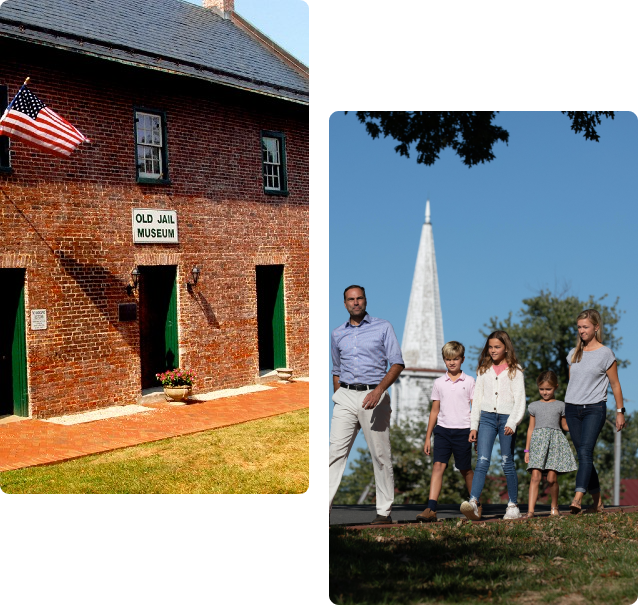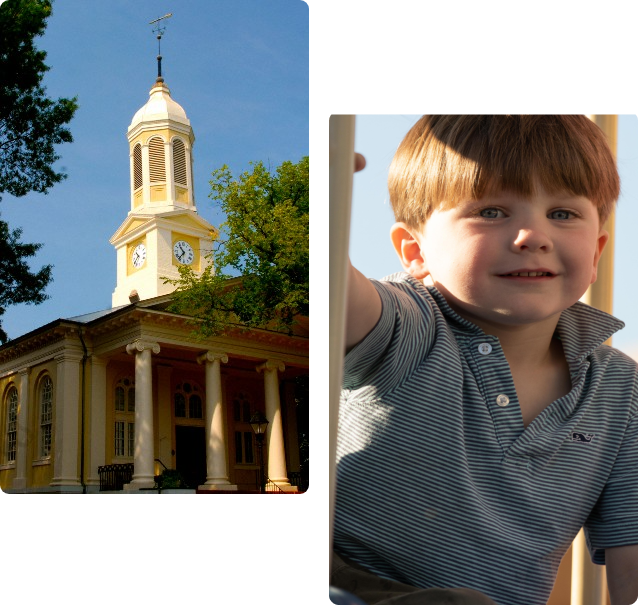Our
Story


Historic Significance & Character
Warrenton, a courthouse community centrally located in Fauquier County, is one of northern Virginia’s principal rural towns. Surrounded by gently rolling countryside known for its pastoral beauty, the town evolved from a small mid-18th-century crossroads community to a thriving political and commercial center throughout the 19th and 20th centuries.
Warrenton boasts an exceptional collection of governmental, residential, and commercial architecture reflecting a wide range of 19th-century styles and tastes as well as the general prosperity of the town in the decades preceding and following the Civil War. Citizens, businesses, and governing agencies of Warrenton remain committed to promoting and protecting the town’s inherited architectural legacy: preserving the past, bolstering the present, and enriching the future.
Early Beginnings
Warrenton is located in the upper Piedmont region of Virginia, 45 miles west of Washington DC at the foot of the Blue Ridge Mountains. As westward movement of settlers from the Virginia Tidewater region moved west, treaties with Native Americans resulted in Virginia families settling in the Piedmont lands. By 1759, a portion of then established Prince William County was dedicated as Fauquier County. The new county seat of government, called the Fauquier Courthouse, was established in the settlement intersection of several important transportation routes; Falmouth-Winchester Roads and Alexander-Culpeper Roads.
During the late eighteenth and early nineteenth centuries, the village prospered by providing goods and services, not only to travelers, but to the numerous farmers in the surrounding agricultural lands. As an overnight respite, travelers between these established commercial centers would stop in Warrenton. This, in turn, hastened the development of the village as a commercial center. By 1760, new courthouse and jail were constructed on the land of statesman Richard Henry Lee.
In December 1790, civic leaders divided the eight-acre village into twelve lots. Rappahannock Road—present-day Main Street—served as the primary thoroughfare. On January 5th, 1810, having achieved sufficient size, Fauquier Court House was formally incorporated, and its name changed to Warrenton. The name served to honor the Warren Academy, the first in a notable line of regional private academies and seminaries. The Warren Academy—named for General Joseph Warren, a New England physician and casualty of the Battle of Bunker Hill— had been built on Academy Hill. After incorporation, the Warrenton Town Council undertook the task of establishing a sensible plan for development. The civic boundary was adjusted to encompass 71 acres. Winding, colonial-era roads were straightened. A grid of streets and lots was surveyed and platted. A nine-mile branch from Orange & Alexandria Railroad main line reached the Town in December 1852 further promoting area development.
Mid-Nineteenth Century
Warrenton continued to grow and develop throughout the early-to-mid nineteenth century. Storehouses and several churches were established in the 19th century with houses and outbuildings built on cast farmland.
During the American Civil War, the town was identified as a valuable, strategic center for communications and provisions. This was aided, in part, by its siting along the Warrenton Branch of the Southern Railway. Captain John Quincy Marr (1825-1861), who had previously served as Mayor of Warrenton, organized the Warrenton Rifles at the outbreak of the Civil War. He subsequently became the first Confederate to be slain in the conflict. Preceding the battles of Second Manassas and Sharpsburg, Warrenton became the scene of important maneuvering. Throughout the war, the town served as an encampment to both Union and Confederate forces while churches and schools were used as general hospitals for all.
Warrenton came to be known throughout the nation for its galaxy of brilliant lawyers who practiced at its bar and as a mecca for the equine industry. Individuals who have made substantial contributions to the fields of national law and politics—Chief Justice John Marshall, Governor William Smith, Congressmen Samuel Chilton, and Eppa Hunton, among others— began their distinguished professional careers in the Town. In 1883 the Warrenton Hunt was established and in 1900 the Warrenton Horse Show, which has achieved national fame as the “Hunter Show of America,” began. In 1922 the first Virginia Gold Cup Race was run. Other hunts, such as the Casanova and Old Dominion, are located within a few miles of the Town.
Growth During the Reconstruction Era
With the Industrial Revolution on the horizon, Virginia’s economy quickly shifted away from the agriculture-based economy of the past. As evidenced by a previously unparalleled period of growth, improvement, and development, Warrenton clearly welcomed this new era. Main Street and part of Alexandria Pike were paved. Religious communities expanded. This included the founding of the First Baptist Church ca. 1868. The fields of law expanded. Both Judge James Keith of the Circuit Court, and Edward M. Spilman of the County Assembly, were attended by 14 attorneys, all of whom had offices in town. The growth of the business community in the late nineteenth and early twentieth centuries was lauded by The True Index, the Warrenton newspaper previously known as Palladium. By 1884, population had grown to 1,464 persons.
Due to its healthful climate, scenic location, and cosmopolitan atmosphere, Warrenton became a noted destination for many nineteenth century vacationers and travelers. One of the primary draws for tourism were Virginia’s abundant natural springs. Nearby Fauquier White Springs, which was advertised as being “…fifty-six miles west of Washington on the Southern Railway, the only direct route between New York, Philadelphia, Baltimore and New Orleans…” contributed to Warrenton’s notoriety as a fashionable, vacationers paradise. The proprietors of the spring touted the healing powers of its waters and reminded would-be vacationers that the springs resort was located a short six-mile distance from Warrenton-proper.
During this period, Warrenton also established is affiliation with the sport of fox hunting. Since the eighteenth century, fox hunting had been a popular sport amongst the plantation owners of Fauquier County. During the third quarter of the nineteenth century, the town became a noted center for the fox hunting by those outside of the Antebellum social elite. In tandem with the rise in the popularity of fox hunting, Warrenton also became a noted center for the breeding of hunting, racing, and show horses. The Warrenton Riding Club was created in 1873, which, in turn, inspired the Warrenton Hunt Club in 1887. In 1899, the renowned Warrenton Horse Show was established at Monterosa-Neptune Lodge.
The Twentieth Century
As travel became easier following the widespread adoption of the automobile, the hinterlands of Fauquier County were developed as equestrian estates by wealthy industrialists. Warrenton served as a social and economic center for this new development.
Warrenton successfully weathered the economic downturn of the Depression, even adding new businesses and buildings. This period of modest growth during a time of stark economic prospects was driven largely by the automobile industry. Several dealerships and service shops had been established by the second quarter of the twentieth century, taking advantage of Warrenton’s location at the intersection of numerous north-south and east-west thoroughfares. Warrenton continued to thrive through the World War II era, expanding and diversifying its business offerings.
In 1982, the Warrenton town council sought to protect the town’s historic and architecturally significant buildings, structures, objects, and sites with the establishment of the Warrenton Historic District, which encompassed the CBD and the oldest residential districts along the town’s historic roads.